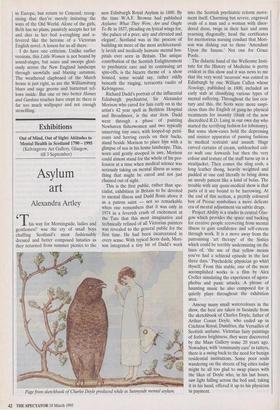Cinema
Little Women (`U', selected cinemas) Mrs Parker and the Vicious Circle (`15', selected cinemas)
America's coming of age
Mark Steyn
Motion pictures seem to check in like a constantly revolving double-feature. So just as Nell arrives, starring Jodie Foster as a free spirit who lives in the backwoods of North Carolina and speaks a language nobody can understand, it's immediately followed by Mrs Parker and the Vicious Cir- cle, starring Jennifer Jason Leigh as a free spirit who lives on the banquettes of the Algonquin and speaks a language nobody can understand — even though Miss Leigh subsequently went back and re-dubbed her voice track with a couple fewer marbles in her mouth.
Then, just as Mrs Parker presents us with one view of the female American writer, Little Women shows up to offer us another. Dorothy Parker is the most-quoted woman in the English-speaking world, but she had difficulty going beyond one-liners. Louisa May Alcott is far less quotable but wrote one indestructible classic which has never been out of print since 1868 and which inspired generations of girls decades before feminism. The Algonquin smartasses didn't have much time for Miss Alcott: they mocked one of their own, Alexander Woollcott, because of his purply, sentimen- tal lapses, as Louisa May Woollcott. He should have been so lucky. Woollcott's name lives today as the inspiration for a cocktail (Brandy Alexander) and The Man Who Came To Dinner, but, like most of the Round Table, his writing is unread and unreadable.
Alan Rudolph's Mrs Parker seems the more grown-up film, Gillian Armstrong's Little Women merely a chocolate-box re- make. Yet, beneath its high style, Mrs Park- er peddles all the clapped-out clichés of the brilliant wit who's a chronic depressive, the great writer with the self-destructive habits, the public success who can't find personal happiness . . . The later life is shot in black-and-white; the film bursts into lush, ripe Rose Room colour for the Algonquin scenes — as if to say: this is what matters, this is when she comes alive. What rot. If Mrs Parker had stayed in her hometown of West End, New Jersey, maybe she'd have turned up a Little Women. As P.G. Wode- house, who spent his lunch-times typing away out on Long Island, used to say of the Round Table: 'Those slackers? When did they ever do any work?' Speaking of slackers, the role of Jo in Little Women goes to that slacker par excel- lence and veteran of Generation X pics like Reality Bites, Winona Ryder. Her predeces- sors include Katherine Hepburn (1933) and June Allyson (1949), but neither has the generational street-cred of Miss Ryder, who makes Alcott's heroine both contem- porary and timeless. We are in Concord, Massachusetts: Father is away at the Civil War and Marmy (Susan Sarandon) and her four daughters find themselves in straight- ened circumstances. The story is essentially autobiographical: Jo wants to be a writer and, at the end, receives the proofs of her first novel ... Little Women. Of course, unlike Miss Alcott, Jo doesn't have the advantage of Thoreau as her neighbour or Emerson as her dad's friend. But otherwise the story and the film share the preoccupa- tions of Miss Alcott's life: women's rights, the temperance movement, Transcenden- talism. Winona Ryder gives a performance that is luminous, true and awfully winning (`Don't say awfully,' as she remarks, 'it's slang') — and, to my mind, the best screen realisation of Jo. I speak here as someone who's traditionally preferred the older, homely sister, Meg.
Subtly and almost imperceptibly, Gillian Armstrong's film stakes itself out from ear- lier versions with a Big Thought: that the March sisters' coming-of-age in the Civil War is a metaphor for America's coming- of-age — or, at any rate, American cul- ture's. We see the sisters putting on plays in the attic about moustachioed English bounders and bosom-heaving Duchesses, but only when Jo writes of what she knows — of her home and community — does she find her own voice; Amy and the boy next door, Laurie, go off to study art and music in Europe, but return to Concord, recog- nising that they're merely imitating the ways of the Old World. Alone of the girls, Beth has no plans, passively accepts her lot and dies in her bed a-coughing and a- fevered like the heroine of a Victorian English novel. A lesson for us all there.
I do have one criticism. Unlike earlier versions, this Little Women is not bound by sound-stages, but soars and swoops glori- ously across the New England landscape through snowfalls and blazing autumns. The weathered clapboard of the March house is just right, as are the Williamsburg blues and sage greens and butternut yel- lows inside. But one or two better Homes and Gardens touches have crept in: there is far too much wallpaper and not enough stencilling.



























































 Previous page
Previous page